
- SAP Community
- Products and Technology
- Enterprise Resource Planning
- ERP Blogs by Members
- Understanding SAP Versions
- Subscribe to RSS Feed
- Mark as New
- Mark as Read
- Bookmark
- Subscribe
- Printer Friendly Page
- Report Inappropriate Content
SAP continues to update their offerings to further improve the user experience. While this is great to ensure our ERP systems have the greatest capabilities possible, it can be hard to keep track that our own systems are up to date. That’s why we put together a list of the SAP versions and how your business can learn more about which version you are operating.
ECC vs. S/4HANA
At the highest level, we can differentiate SAP systems as either ECC or S/4HANA. The main difference between the two is the type of database they use.
ECC stands for ERP Central Component. It is SAP’s legacy system, with roots stretching back to their very first ERP solution in the 1970s. It can operate on any database, including third-party and, more recently, HANA. New versions of ECC are not being released and it is expected that customers will transfer their systems over to S/4HANA.
S/4HANA is short for SAP Business Suite 4 HANA. As the fourth version of the SAP Business Suite, it is the latest offering from SAP. It runs only on the HANA database, which is an in-memory database developed and tuned by SAP for faster performance and real-time reporting.
Let’s dive into more details.
S/4HANA Versions
S/4 HANA is offered on two different platforms: On-Premise or Cloud. Both products are very similar in terms of lines of business, coverage, and functionality.
On-Premise is located on your organization’s own servers and managed in-house. It has an annual innovation cycle with several smaller updates each year.
Cloud is hosted externally on SAP’s servers and maintained by SAP. It has a quarterly innovation cycle.
Until 2020, all S/4HANA versions were named after the year and month that they were released (YYMM). For example, S/4HANA 1909 was released in September 2019.
SAP revised the naming convention in 2020. Going forward, On-Premise releases will be named for the year only (YYYY), starting with S/4HANA 2020 in October 2020. Cloud releases will continue with the YYMM naming convention.
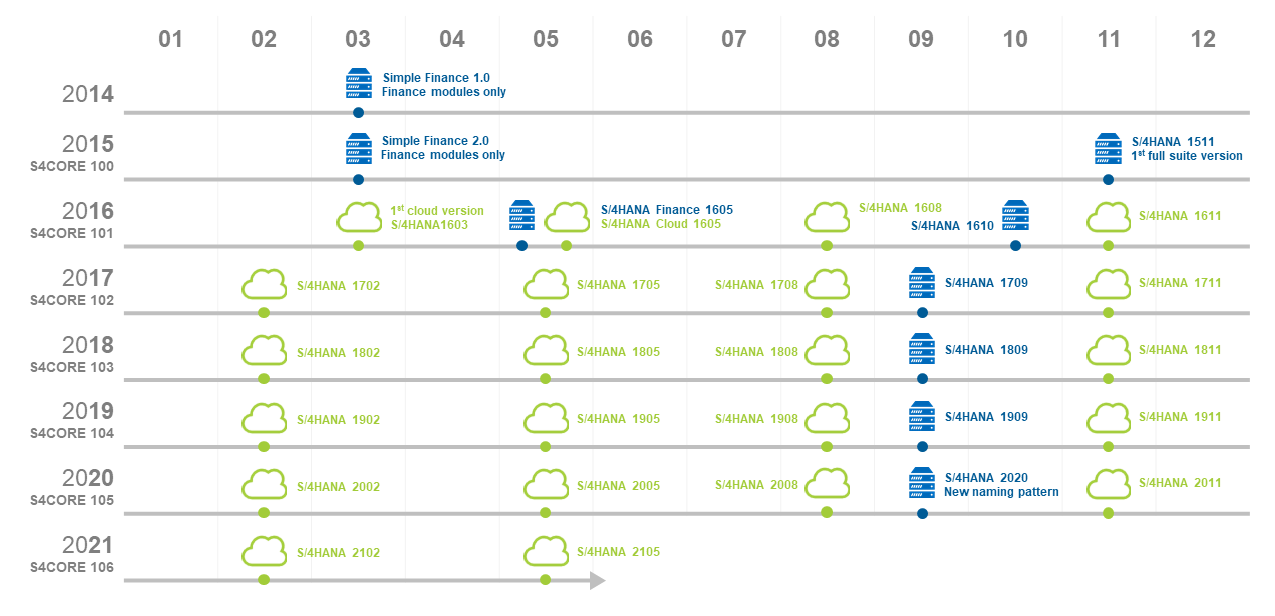

More > System > Status > SAP System Data > Installed Software Component Versions.

S/4HANA On-Premise Versions
S/4HANA On-Premise also has several updates for each version per year. These updates will either be Feature Pack Stacks (FPS) for new features or Support Pack Stacks (SPS) for bug fixes.
The versions are outlined as follows:

SAP HANA Database Versions
S/4HANA operates on the HANA (High performance ANalytic Appliance) database.
For reference the two versions referred to are HANA DB 1.00.122 (HANA 1.0 SP12 Rev 122) and HANA DB 2.00.052.0 (HANA 2.0 SPS05 Rev 52).
The HANA 1.0 database will reach end-of-maintenance in June 2021.
SAP will provide Maintenance Revisions for SAP HANA 2.0 SPS05 for a period of five years after RTC. These Revisions after SPS05 are not scheduled but delivered on demand. Bug fixes and security patches are released for every Support Package Stack (SPS) for two years after RTC.
SAP will introduce new capabilities once a year, every time a new SAP HANA Support Package Stack (SPS) is released. An overview can be found in SAP HANA 2.0 Revision Strategy.
SAP HANA 1.0

SAP HANA 2.0

ECC Versions
SAP ECC (SAP ERP Central Component) This is the predecessor for SAP S/4HANA. As a result, ECC 6.0 EHP 618 is the final release since SAP expects customers will transfer their systems to S/4HANA. The “1” in the version number states that it is enabled for the HANA database.
To identify the version, check SAP_APPL component version in the system stack information.
The updates can be viewed in this diagram:
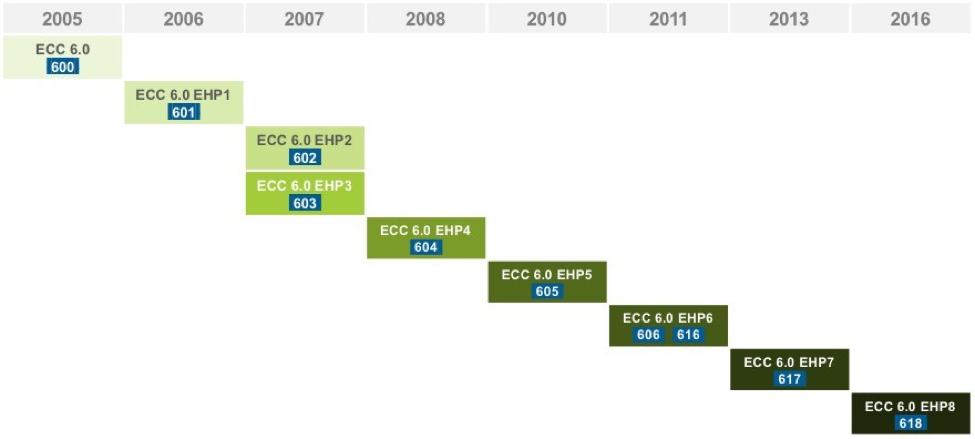
To look up the version of your system, go to: More > System > Status > SAP System Data > Installed Product Versions. This will tell you the product name.

Technical folks may be more interested in the SAP_APPL component version, which can be found nearby:
More > System > Status > SAP System Data > Installed Software Component Versions.

NetWeaver Versions
SAP NetWeaver (NW) is the underlying technology layer or software stack that ECC is built on. SAP NW can be used for custom development and integration with other applications and systems and is most commonly build using the ABAP programming language. As of 2019, the most up to date version of NetWeaver is AS ABAP 7.54.
EHP Stands for EnHncement Package.
AS stands for Application Server.
To identify the version that your business is operating, check the SAP_BASIS component version in the system stack info (More > System > Status > SAP System Data > Installed Software Component Versions).
The version releases are as follows:
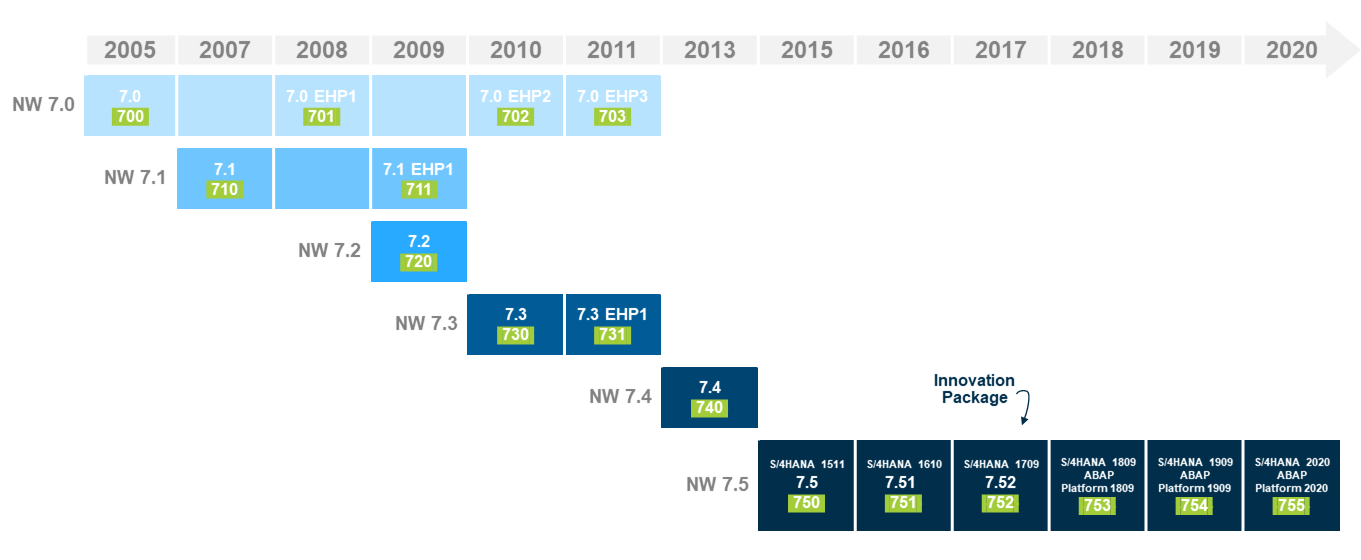
Fiori Versions
SAP Fiori is the new SAP interface, which appears as a set of apps addressing the most frequently used SAP functions. Previously known SAP GUI transactions are now composed into Fiori apps that users can personalize using Launchpad to further improve the user experience.
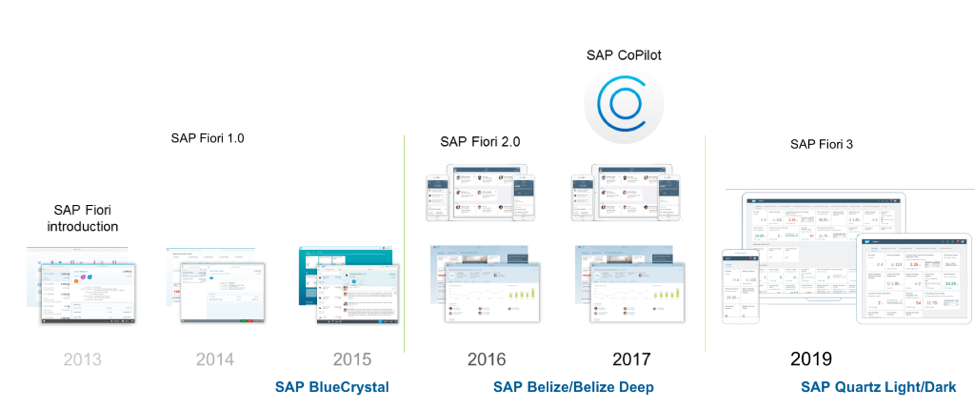
- SAP Fiori Introduction was released in 2013, followed by SAP Fiori 1.0.
- SAP BlueCrystal theme came out the following year in 2015.
- In 2016 SAP Belize/Belize Deep themes was released in Fiori 2.0.
- The current version is Fiori 3 (not Fiori 3.0!) with the SAP Quartz Light/Dark theme. It is a totally new theme with a fresh, modern look and revised homepage design.
UI5 Versions
On the development side, SAP user interface for HTML 5 (SAPUI5) is the collection of libraries that are used to build desktop and mobile applications. UI5 versions must be considered for Cloud only & On-Premise deployments.
To identify the UI5 version, type sap.ui.version in browser developer tools. From there navigate to the console tab for more information.
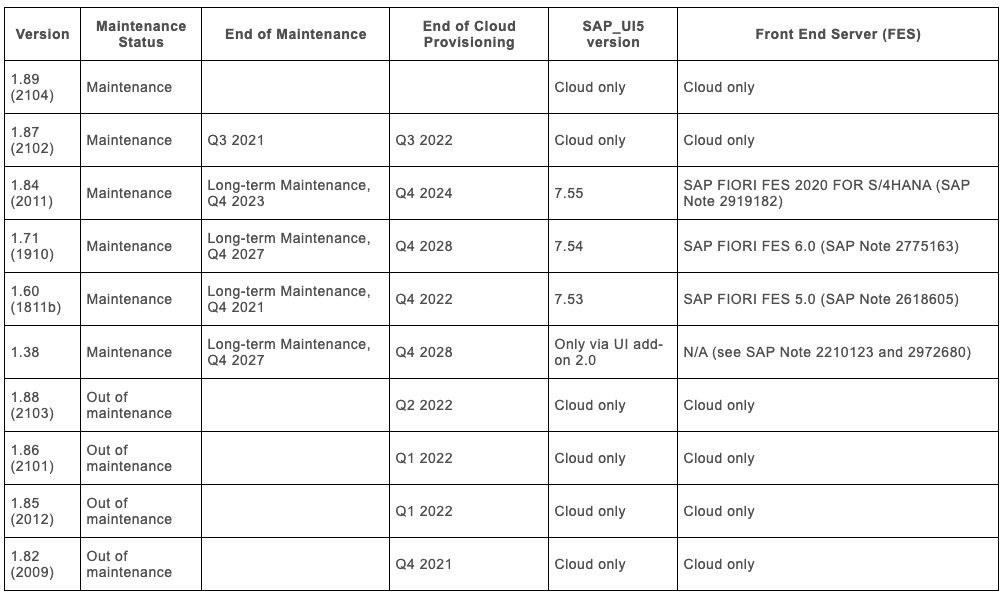
For more up-to-date information, go to the official SAPUI5 Version Overview.
SAPUI5 VERSIONS AVAILABLE ON SAP BUSINESS TECHNOLOGY PLATFORM
SAPUI5 is switching from a quarterly to a monthly cloud delivery via SAP Business Technology Platform (BTP). This means every four weeks a new version is provided for productive usage and version numbers will increase by one instead of by two. Additionally, every 12th version will become a long-term maintenance version.
It is important to note that only versions with long-term support receive patches for the duration of the maintenance.
Bug fixes will also be released in the next version.
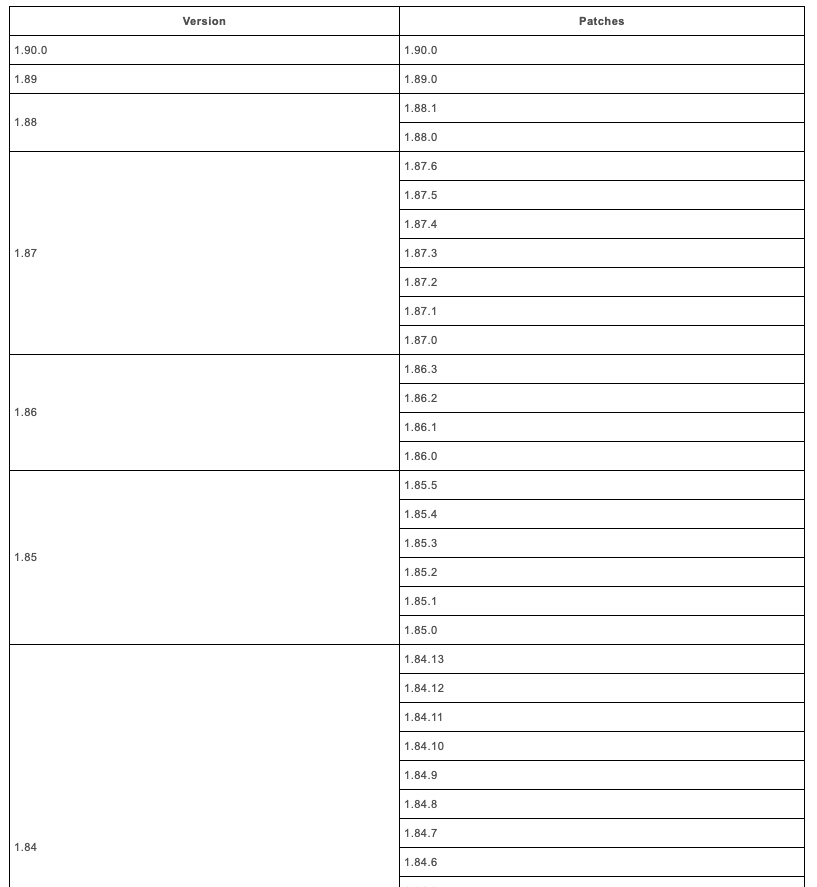
For more up-to-date information, go to the official SAPUI5 Version Overview.
For help optimizing your SAP system or migrating to S/4HANA we encourage you to contact us today!
- SAP Managed Tags:
- SAP Fiori,
- SAPUI5,
- SAP ERP,
- SAP HANA,
- SAP NetWeaver,
- SAP S/4HANA
You must be a registered user to add a comment. If you've already registered, sign in. Otherwise, register and sign in.
-
"mm02"
1 -
A_PurchaseOrderItem additional fields
1 -
ABAP
1 -
abap cds
1 -
ABAP CDS Views
1 -
ABAP CDS Views - BW Extraction
1 -
ABAP CDS Views - CDC (Change Data Capture)
1 -
ABAP Extensibility
1 -
ACCOSTRATE
1 -
ACDOCP
1 -
Adding your country in SPRO - Project Administration
1 -
Advance Return Management
1 -
AI and RPA in SAP Upgrades
1 -
API and Integration
1 -
Approval Workflows
1 -
Ariba
1 -
ARM
1 -
ASN
1 -
Asset Management
1 -
Associations in CDS Views
1 -
auditlog
1 -
Authorization
1 -
Availability date
1 -
Azure Center for SAP Solutions
1 -
AzureSentinel
2 -
Bank
1 -
BAPI_SALESORDER_CREATEFROMDAT2
1 -
BRF+
1 -
BRFPLUS
1 -
Bundled Cloud Services
1 -
business participation
1 -
Business Processes
1 -
CAPM
1 -
Carbon
1 -
CDS Annotations
1 -
Cental Finance
1 -
CFIN
1 -
CFIN Document Splitting
1 -
Cloud ALM
1 -
Cloud Integration
1 -
condition contract management
1 -
Connection - The default connection string cannot be used.
1 -
Custom Table Creation
1 -
Customer Screen in Production Order
1 -
Customizing
1 -
Data Quality Management
1 -
Date required
1 -
Decisions
1 -
desafios4hana
1 -
Developing with SAP Integration Suite
2 -
Direct Outbound Delivery
1 -
DMOVE2S4
1 -
EAM
1 -
EDI
3 -
EDI 850
1 -
EDI 856
1 -
edocument
1 -
EHS Product Structure
1 -
Emergency Access Management
1 -
Employee Central Integration (Inc. EC APIs)
1 -
Energy
1 -
EPC
1 -
Financial Operations
1 -
Find
1 -
FINSSKF
1 -
Fiori
1 -
Flexible Workflow
1 -
Gas
1 -
Gen AI enabled SAP Upgrades
1 -
General
1 -
generate_xlsx_file
1 -
Getting Started
1 -
HomogeneousDMO
1 -
How to add new Fields in the Selection Screen Parameter in FBL1H Tcode
1 -
IDOC
2 -
Integration
1 -
Learning Content
2 -
Ledger Combinations in SAP
1 -
LogicApps
2 -
low touchproject
1 -
Maintenance
1 -
management
1 -
Material creation
1 -
Material Management
1 -
MD04
1 -
MD61
1 -
methodology
1 -
Microsoft
2 -
MicrosoftSentinel
2 -
Migration
1 -
mm purchasing
1 -
MRP
1 -
MS Teams
2 -
MT940
1 -
Newcomer
1 -
Notifications
1 -
Oil
1 -
open connectors
1 -
Order Change Log
1 -
ORDERS
2 -
OSS Note 390635
1 -
outbound delivery
1 -
outsourcing
1 -
PCE
1 -
Permit to Work
1 -
PIR Consumption Mode
1 -
PIR's
1 -
PIRs
1 -
PIRs Consumption
1 -
PIRs Reduction
1 -
Plan Independent Requirement
1 -
POSTMAN
1 -
Premium Plus
1 -
pricing
1 -
Primavera P6
1 -
Process Excellence
1 -
Process Management
1 -
Process Order Change Log
1 -
Process purchase requisitions
1 -
Product Information
1 -
Production Order Change Log
1 -
purchase order
1 -
Purchase requisition
1 -
Purchasing Lead Time
1 -
Redwood for SAP Job execution Setup
1 -
RISE with SAP
1 -
RisewithSAP
1 -
Rizing
1 -
S4 Cost Center Planning
1 -
S4 HANA
1 -
S4HANA
3 -
S4HANACloud audit
1 -
Sales and Distribution
1 -
Sales Commission
1 -
sales order
1 -
SAP
2 -
SAP Best Practices
1 -
SAP Build
1 -
SAP Build apps
1 -
SAP Business One
1 -
SAP Business One Service Layer
1 -
SAP CI
1 -
SAP Cloud ALM
1 -
SAP CPI
1 -
SAP CPI (Cloud Platform Integration)
1 -
SAP Data Quality Management
1 -
SAP ERP
1 -
SAP Maintenance resource scheduling
2 -
SAP Note 390635
1 -
SAP S4HANA
2 -
SAP S4HANA Cloud private edition
1 -
SAP Subcontracting Process
1 -
SAP Upgrade Automation
1 -
SAP WCM
1 -
SAP Work Clearance Management
1 -
Schedule Agreement
1 -
SDM
1 -
security
2 -
Settlement Management
1 -
soar
2 -
Sourcing and Procurement
1 -
SSIS
1 -
SU01
1 -
SUM2.0SP17
1 -
SUMDMO
1 -
Teams
2 -
Time Management
1 -
User Administration
1 -
User Participation
1 -
Utilities
1 -
va01
1 -
vendor
1 -
vl01n
1 -
vl02n
1 -
WCM
1 -
X12 850
1 -
xlsx_file_abap
1 -
YTD|MTD|QTD in CDs views using Date Function
1
- « Previous
- Next »
- Automatic clearing of bank interim account for outgoing payments with reference number in Enterprise Resource Planning Q&A
- Various Subcontracting Scenarios Using Functionalities in S4HANA. in Enterprise Resource Planning Blogs by Members
- Streamlining Customer Business Partner Creation in SAP Using BAPIs in Enterprise Resource Planning Q&A
- Why YCOA? The value of the standard Chart of Accounts in S/4HANA Cloud Public Edition. in Enterprise Resource Planning Blogs by SAP
- How to keep PDF file created by output control? in Enterprise Resource Planning Q&A
| User | Count |
|---|---|
| 7 | |
| 1 | |
| 1 | |
| 1 | |
| 1 | |
| 1 | |
| 1 | |
| 1 | |
| 1 | |
| 1 |